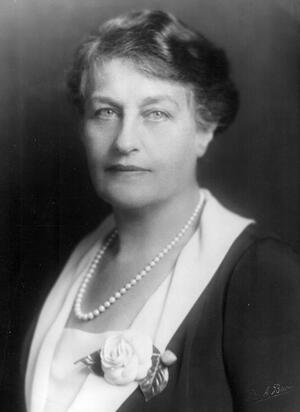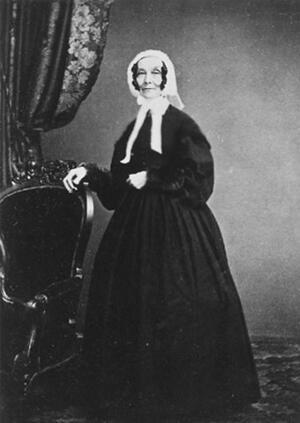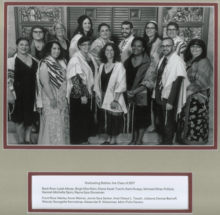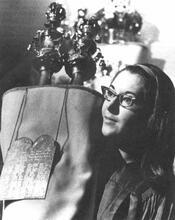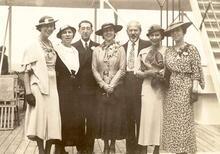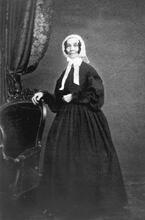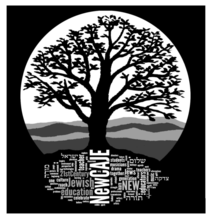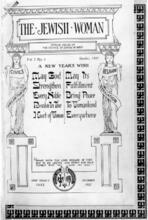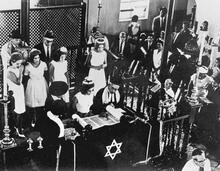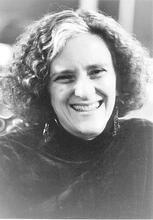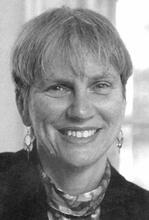Hebrew Teachers Colleges in the United States
The past thirty years has seen a radical reshaping of Hebrew Teachers Colleges and teacher training programs in Jewish education in the United States. Many of these institutions have closed, merged into larger local universities or expanded their focus and programs. Financial stability and viability became a major contributing factor to the decline of these historic and storied institutions. On the other hand, millions of dollars have been poured into the funding of graduate students going into Jewish education, hopefully levelling the playing field between men and women. While Jewish classroom teaching has always been the preserve of women, leadership positions in schools, universities, and even rabbinical schools have welcomed women into their ranks during the opening decades of the twenty-first century.
Introduction
The past thirty years have seen a radical reshaping of Hebrew Teachers Colleges and teacher training programs in Jewish education in the United States. Many of these institutions have closed, merged into larger local universities, or expanded their focus and programs. Financial stability and viability became a major contributing factor to the decline of these historic and storied institutions. Many of the Hebrew Teachers Colleges had depended on the local Jewish federations for the bulk of their funding, and as the amount of that funding decreased and the cost of maintaining both salaries and physical structures increased, it became impossible to sustain them. Unlike major universities with a diverse base of alumni, Hebrew Teachers Colleges have a rather narrow base of alumni of modest means who could not be depended upon to provide the necessary financial support. The proliferation of on-line programs in the second decade of the twenty-first century allowed for greater flexibility in scheduling and geographical location. A student in the United Kingdom can take a morning class on the East Coast of the United States while on a lunch break. The Covid pandemic that began in the winter of 2020 furthered the trend towards online learning, as most institutions of higher learning became exclusively online.
While many institutions have faced several financial challenges, funding for individual students to pursue graduate studies in Jewish education has increased tremendously since the beginning of the twenty-first century. A 2017 investigation commissioned by the Association of Institutions of Higher Learning in Jewish Education (ALOHA), spearheaded by Rabbi Michael Shire, indicated tremendous growth in both full- and part-time students undertaking graduate degree programs in Jewish education. The report surmises that most part-time students are already working in Jewish educational settings (about 50% in day schools) and that these students receive substantial funding to further their education. Though the majority of all master’s students attend part time, full-time enrollment increased by 80% during the 2014-2015 academic year (Shire, 6). Between 2005 and 2015, 86% of graduating students received funding worth at least 50% of tuition (Shire, 9). The study does not break down students by gender, but most of those in Jewish classrooms are female identified. These millions of dollars spent on teacher training should level the playing field and help achieve gender parity in teacher education outcomes.
While women have garnered more positions of leadership in Hebrew Teachers Colleges and their successor institutions since the latter decades of the twentieth century, the lens through which gender and gender equity are viewed also changed. Second-wave feminism emerged in the 1960s, followed by radical feminism in the 1970s. The late twentieth and early twenty-first centuries saw the expansion of ideas of gender that go beyond male and female. The Jewish community also realized that gender and gender equity had to be seen through the lens of gender non-binary and gender non-conforming identities, and positions of educational leadership in the Jewish community also must be viewed in that light. These issues and others were raised in a seminal study entitled Gender Equity and Leadership Initiative, by Drs. Shira D. Epstein and Andrea Jacobs and published by JTS in 2019.
Early History: Nineteenth Century through World War I
During the early waves of immigration to the United States, Descendants of the Jews who lived in Spain and Portugal before the explusion of 1492; primarily Jews of N. Africa, Italy, the Middle East and the Balkans.Sephardi and German Jews established full-time schools in large population centers. Rabbis, clergy, and predominantly European-trained male teachers provided religious instruction in private-school settings, often sponsored by and housed in synagogues.
When Rebecca Gratz established the Hebrew Sunday School Society in Philadelphia (1838), teachers were “appointed from among the young ladies” of the Mikveh Israel Congregation. Similarly, in Baltimore, the “teaching ladies” were unwed, well-meaning, untrained women who provided instruction in the local Reform Sunday schools. There was no profession of Jewish education in nineteenth-century America.
While experienced teachers came to the United States with each immigrant group, among the millions of Eastern European Jews who arrived in the late nineteenth and early twentieth centuries were melamdim [teachers] who were well-suited to the task of training children in traditional Eastern European ways but not well equipped for training children in the new country. While parents sought an education that would keep their children “traditional,” the children found little appeal in an educational system that prepared them to live their parents’ lives.
Two teacher-training institutions were established prior to World War I: Gratz College (1897) and the Teachers Institute of the Jewish Theological Seminary (1909). As Diane A. King wrote in “A History of Gratz College 1893–1928,” “Even the well-educated East Europeans who were engaged in teaching could not be spoken of as trained teachers.” Gratz was intended to fill this need. There were eight women and five men in Gratz’s first afternoon class, and twelve women and nine men in its first evening class. The list of twenty-one scholarship recipients for the years 1901 to 1908 includes only three women. Because Gratz’s early emphasis was the training of Sunday school teachers, some do not consider it to be the first Jewish teacher’s training school, as Sunday school teachers were not seen as professional educators. In 1910, according to Alexander Dushkin, “There was not a single Jewish teacher’s training school in the country for the training of professional teachers.”
The 1886 charter of the Jewish Theological Seminary included as one of its objectives “the establishment and maintenance of a Jewish Theological Seminary for the training of Rabbis and teachers.” From its inception, the Teachers Institute welcomed able female students: “Any Jewish man or women of good character above the age of fifteen who in the opinion of the President of the Faculty is capable of profiting by the course may be admitted as a student.” By 1919, fifty-seven women and sixty-eight men were enrolled: The significant number of women included the “girl graduates of the first class of the Hebrew High School of the Bureau,” a group of students with thorough Hebrew training.
The Interwar Period through the 1950s
Nine additional schools were established in the decade following World War I: the Teachers Institute of Mizrachi Zionist Organization (1917), later affiliated with Yeshiva University (1921); the Jewish People’s Seminary (1918); Baltimore Hebrew Teachers College (1919); the Hebrew Teachers College of Boston (1921); Herzliah Hebrew Teachers Institute (1923); the College of Jewish Studies of Chicago (1926); Spertus Institute, then known as the College of Jewish Studies, which opened its doors in Chicago in 1924 as a division of the Board of Jewish Education; the Hebrew Teachers Training School for Girls (1928), later affiliated with Yeshiva University; and the Hebrew Union College School for teachers, founded in 1920 and reorganized in 1947 as the Hebrew Union College–Jewish Institute of Religion School of Sacred Music and School of Education.
The founders of Boston Hebrew College felt the need for American scholars and cultured laypeople. They wanted “a spiritual elite for New England … who would be able to mold a creative and vigorous generation with a sense of belonging to a revitalized Jewish community.” A difficult goal such as this would be unattainable unless the elite had “a profound knowledge of Jewish sources and general erudition.”
Each school was unique in some way, yet some shared characteristics. Community-sponsored schools were established to meet predominantly local needs. They were, and remain, supported locally as a responsibility of the community and as an indication of the community’s commitment to Jewish education. These schools drew the majority of their students from the local area, and graduates tended to remain in the community. Many of these schools grew out of the Tarbut movement, a cultural and educational movement begun in Russia after the Revolution and committed to a revitalization of the Hebrew language. The first Ivrit b’ Ivrit [Hebrew in Hebrew] classes were in Boston and New York, and cities such as Baltimore followed suit. In time, all Hebrew teachers colleges would go beyond training classroom teachers and prepare students for work in adult education, Sunday schools, youth groups, and advanced studies leading to the rabbinate (at first for men only) or academic careers. The curricular emphasis was on the study of classical texts, Hebrew language and literature, and cultural Zionism. Religious practices were not widely practiced, although all food was Term used for ritually untainted food according to the laws of Kashrut (Jewish dietary laws).kosher, boys wore kippot in class, and services on Shabbat retreats were usually Orthodox, at least in practice.
According to Diane King, “The large number of women who were prepared to undertake advanced Jewish education particularly in the 1920s probably reflected the growth in the number of Lit. "study of Torah," but also the name for organizations that established religious schools, and later the specific school systems themselves, including the network of afternoon Hebrew schools in early 20th c. U.S.Talmud Torah schools during this period … a system which attracted girls as well as boys.” The growth of Hebrew teachers colleges would in time depend on the enrollment and education of girls and young women in the Talmud Torah system.
According to the 1921–1922 registry of Baltimore Hebrew College, male or female applicants from sixteen years of age and upward were encouraged to apply for admission. Nine students—six women and three men—enrolled in Herzliah when it opened in 1927. Its aim was to train young women to become teachers in Hebrew schools, where male teachers were predominant. There were no female faculty members at Herzliah for many years. Early students recalled that the only female presence was the school secretary.
The early Hebrew teachers colleges were male-dominated institutions. Women’s participation in governance was limited to the activities of the women’s auxiliaries, with the notable exception of Frieda Warburg, who served as a director of the Jewish Theological Seminary of America (JTSA). Few women served on the faculties of the Hebrew colleges in the first decades of their existence. In describing the accomplishments of the Teachers Institute, Mordecai M. Kaplan wrote in 1939: “All this that the Teachers Institute and its affiliated departments have achieved would not have been possible without the men of the faculty.” Part-time and adjunct faculty positions were occupied by specialists such as Judith Kaplan Eisenstein (music at JTSA), Temima Nimtzowitz Gezari (arts and crafts at JTSA), and Shulamith Scharfstein Chernoff (nursery education at JTSA). Instructors of Hebrew within the college programs at JTSA included Rebecca Aaronson Brickman (1911–1914) and Rose Abramson Maximon (1912–1914).
Women were camp directors, teaching supervisors, librarians, and assistant librarians (Jeanette Newman Bloom, Helen Sarna, and later Anne Lapidus Lerner at Boston Hebrew College). No women are included in the list of the leadership of the profession of Jewish education in the 1920s and 1930s “in the United States and their writings that represent the professional literature” of the period.
From 1929 to 1954, community-based colleges including the Hebrew Teachers Seminary in Cleveland, the School of Jewish Studies in Pittsburgh, and the Midrasha/College of Jewish Studies in Detroit were established. The Teachers Institute of the University of Judaism (1947), Brandeis University (1948), the Teachers Institute for Women of Yeshiva University (1952), and Stern College for Women of Yeshiva University (1954) were established following World War II.
By 1950, Hebrew teachers colleges, partly because of their encouragement of secular studies for their students and graduates, were meeting only twenty-five percent of the need for classroom teachers in Jewish schools. They expanded beyond teacher training to undergraduate and graduate programs in Jewish studies, and by 1981 the term “Hebrew” had been dropped from the official name of all but a few schools. Hebrew was the language of instruction for only about twenty percent of the courses offered. In 1951, the Iggud Betey Midrash: Association of Hebrew Teachers Colleges was established to bring together accredited Jewish teachers training institutions.
Major curriculum revisions occurred in the mid-1950s to meet the changing needs of schools. For many years, the schools had been subject to criticism by professional educators. Teachers were still being prepared for traditional approaches in traditional self-contained classrooms. Courses of study did not reflect the changing nature of American Jewish life and developments in general education. Israel programs were added, as were specialized tracks to prepare experienced teachers for administrative positions. Now, the colleges as a group often recruit from similar applicant pools and offer training for the full range of careers in Jewish education. Most concentrate their efforts on graduate training.
The synagogue school became the most popular form of American Jewish education in the mid-twentieth century; by the mid-1980s, ninety percent of school-age children who were enrolled in Jewish schools were in this setting.
The Late Twentieth and Early Twenty-First Centuries
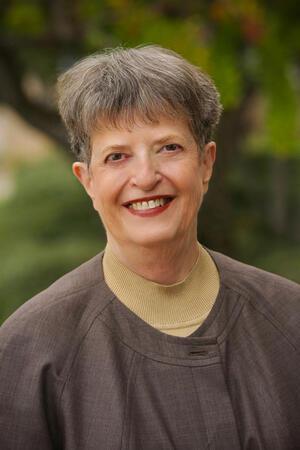
Sara Lee transformed Jewish schools and education.
Courtesy of Hebrew Union College
Women Move Into Administrative Positions
Sylvia Cutler Ettenberg (JTS) and Elsie Chomsky (Gratz) were the first women to hold full-time and administrative positions in teachers colleges. In 2020, Dr. Honour Moore was appointed Dean of Gratz College, where Dr. Ruth Sandberg holds the Leonard and Ethel Landau Chair in Rabbinics. Joy Goldstein was appointed as Gratz’s first female president in 2011, serving in that position until 2016; prior to working at Gratz, she was the chief planning and funding officer of the Jewish Federation of Greater Philadelphia, and she returned to the Federation world afterwards. Dr. Shira Epstein was named dean of the William Davidson Graduate School of Jewish Education at JTS in 2019 and in 2020, Dr. Shuly Rubin Schwartz was named the school’s first female chancellor.
Norma Field Furst served as president of Baltimore Hebrew University (1993–1995), and eminent sociologist Dr. Rela Mintz Geffen served as its sixth president (2000-2007). In 2009, the Baltimore Hebrew University closed its doors and several of its programs were merged into the Baltimore Hebrew Institute of Towson University, where Dr. Hana Bor is the Program Director for Leadership in Jewish Education & Communal Service graduate programs. The Institute offers post-baccalaureate certificates in Jewish education and Master’s degrees in Leadership in Jewish Education.
Rabbi Sharon Cohen Anisfeld serves as president of Hebrew College in Boston, which awards a Master's in Jewish Education designed as in-service for current educators; it also partners with Pardes Institute in Israel, awarding a Master's degree in Jewish Education for Day School teachers. Ninety percent of its graduate education students are women.
Sara S. Lee served as director of the Rhea Hirsch School of Education of Hebrew Union College-Jewish Institute of Religion (1980-2007). In 2016, Dr. Miriam Heller Stern was named National Director of the School of Education; she oversees the teacher training programs of all HUC-JIR campuses. Dr. Rachel Lerner serves as dean of the School for Jewish Education and Leadership, formerly known as the Graduate Center for Jewish Education at the University of Judaism in Los Angeles.
Dr. Lifsa B. Schachter served as professor of education for many years at The Cleveland College of Jewish Studies. In 2015, the Cleveland College closed and merged with Case Western Reserve; it is now known as the Laura and Alvin Siegal Life Long Learning Program.
Jewish Teacher Training Programs in Secular Universities and Seminaries
Gratz College and the University of Pennsylvania were the first to propose a joint degree program between a Jewish teacher training school and a local secular college, but it was never developed. In 1930, the Jewish Theological Seminary arranged with Teachers College of Columbia University for students to complete a combined course and receive the degrees of bachelor of science in education from Columbia and bachelor of Jewish pedagogy from the Teachers Institute. Herzliah urged its graduates to attend a secular school and, following graduation, implemented a plan for students to enroll in New York University’s School of Education. Hebrew Union College and the University of Southern California also developed joint programs, as did the College of Jewish Studies in Chicago and Roosevelt University.
Secular universities, as well as schools like HUC-JIR and JTS that are part of an academic institution, have also established programs and degrees in Jewish education. JTS offers a Master of Jewish Education, with tracks in educational leadership and pedagogy and teaching, with options for full-time in-house and in-person, part-time, and online courses of study. The school also offers a hybrid online/in-person Executive Leadership EdD program. In addition to degree programs, the school offers intensive professional leadership programs for day school heads of school (DSLTI), day school Judaic studies educators (Standards and Benchmarks), and early childhood leaders (JECELI). The William Davidson School supports faculty-led applied and field-based research and initiatives. HUC-JIR offers a Master of Educational Leadership and concurrent MA in Jewish Learning for emerging educational leaders; the Executive MA in Jewish Education for mid-career leaders; and DeLeT, a teaching credential and Master of Arts in Teaching program for Jewish day school teachers, in addition to an array of professional learning offerings in the field. Local in-person and national/hybrid programs are currently administered from the Rhea Hirsch School of Education in Los Angeles.
Brandeis University, founded in 1948, offers an MAT through its education department; in conjunction with the Hornstein Jewish Professional Leadership Program, it also offers an EdM in Jewish Educational Leadership. The faculty of the Hornstein Program is evenly divided between men and women, and its director is Rabbi Shirley Idelson. Dr. Erica Brown is the director of the Mayberg Center for Jewish Education and Leadership at George Washington University, where she also serves an as associate professor of curriculum and pedagogy. The university grants a graduate certificate in teaching strategies and classroom management for Jewish studies educators and students can also earn a Master's in Curriculum and Instruction. Although not in the United States, McGill University in Montreal offers a Jewish Teacher Training Program, from which over 200 students have graduated since 1973 on both the undergraduate and graduate level.
Currently Gratz has expanded its offerings to include BA completion and graduate programs on both the master’s and doctoral levels in Jewish and secular education, to serve evolving populations and to provide additional revenue streams.
Student Body in the Twenty-First Century
Students who now enter preparatory programs for teaching are often lacking in fundamental knowledge of Hebrew unless they have strong day school backgrounds; they often come from nonobservant homes and are strongly influenced by experiences in Jewish camps, Israel programs, day schools, and youth groups. Many prepare for careers in education that take them beyond traditional classroom settings to programs in informal settings, family and adult education, camping, and retreats. A broader range of career options is available to the granddaughters and great-granddaughters of the early female graduates of Hebrew teachers colleges. Yet the most prestigious and most highly paid positions in Jewish education remain in the hands of those who identify as male (Epstein and Jacobs, p. 15).
Conclusion
In the twenty-first century, Jewish women have made great strides both as leaders of Jewish teacher training institutions and as heads of major Jewish educational establishments.
The traditional Hebrew Colleges founded in the early twentieth century have closed, been absorbed by other institutions, or expanded their missions. As noted above, the Baltimore Hebrew College is now the Baltimore Hebrew Institute at Towson University, and the Cleveland College of Jewish Studies is now an adult education institute known as the Laura and Alvin Siegal Lifelong Learning Program at Case Western Reserve University. The Boston Hebrew College’s crown jewel is its rabbinical school, and Gratz College in Philadelphia now grants graduate degrees and certificate programs beyond training teachers in the field of Jewish education. The major seminaries continue to run traditional Jewish teacher training programs and have expanded their offerings to meet the needs of twenty-first-century professionals. Most of these schools are currently headed by women, and the breakthrough in the stained-glass ceiling was the appointment of Dr. Shuly Rubin Schwartz as Chancellor of The Jewish Theological Seminary in 2020.
When this encyclopedia was first compiled in the 1990s, it was a rarity for a woman to be the head of school at a major Jewish day school in the United States. Those days are gone. Dr. Shulamith Reich Elster (1939-2021), the original author of this article, served as head of school of the Charles E. Smith Jewish Day School in Rockville, MD, from 1982 to 1990, and Dr. Joyce Raynor (subsequently ordained by JTS while head of school) served as head of school at the Golda Och Academy in West Orange, NJ, from 2007 to 2015. Both women started at their respective schools many years before being appointed head, which may show that in previous years women had to “show their mettle” before they could ascend the top ranks. More recently, other women who have reached the pinnacle of Jewish education have come from outside the ranks of Jewish teacher training programs. Ariela Dubler, for example, was appointed head of the prestigious Abraham Joshua Heschel Jewish Day School in Manhattan, having bypassed any training in formal Jewish education; instead, she came from a tenured position on the faculty of the Columbia University School of Law.
While some women have achieved the top positions that served as the traditional measure of success in the field, however, important questions and challenges remain. Being head of school, with all of its pressures and strains, is no longer the only measure of success for women; women may take alternate paths to leadership and success in the field of Jewish education. Moreover, a survey of the graduates of prestigious training programs, indicates that the salary gap, the prestige gap, and the job satisfaction gap between men and women remain substantial (Epstein and Jacobs). And perhaps most importantly, how are the questions educators ask different now that women have significant leadership roles? In institutions that profess to be egalitarian, why are both boys and girls taught about wearing tallit and tefillin but only boys are required to wear them? These questions will continue to change as understandings of gender continue to evolve.
Davidson, Aryeh. The Preparation of Jewish Educators in North America: A Status Report to the Commission on Jewish Education in North America. Commission on Jewish Education in North America, 1990.
Dushkin, Alexander M., with Nathan Greenbaum. Comparative Study of the Jewish Teachers Training Schools in the Diaspora. Jerusalem: Institute of Contemporary Jewry, Hebrew University, 1970.
Epstein, Shira D. and Jacobs, Andrea. Gender Equity and Leadership Initiative: A Research and Planning Task Force of the Leadership Commons. New York: William David Graduate School of Jewish Education, JTS, Spring 2019.
Janowsky, Oscar J., ed. The Education of American Jewish Teachers. Boston: Beacon Press, 1967.
King, Diane A. “A History of Gratz College 1893–1928.” Ph.D. diss., Dropsie College, 1979.
Margolis, Isidor. Jewish Teacher Training Schools in the United States. National Council for Torah Education of Mizrachi-Hapoel Hamizrachi, 1964.
Reimer, Joseph, ed. To Build a Profession: Careers in Jewish Education. Waltham, MA: Brandeis University Press, 1987.
Schiff, Alvin. “New Models in Preparing Personnel for Jewish Education: Overview of Programs.” Jewish Education 43, no. 3 (Fall 1974).
Shire, Michael (Chairman). State of Graduate Jewish Education in the United States, Association of Institutions of Higher Learning in Jewish Education (ALOHA), November 2017.
Steiner, M.J. “Hebrew Teachers College of Boston: 1921–1951.” Jewish Education 23, no. 1 (Winter 1952).

